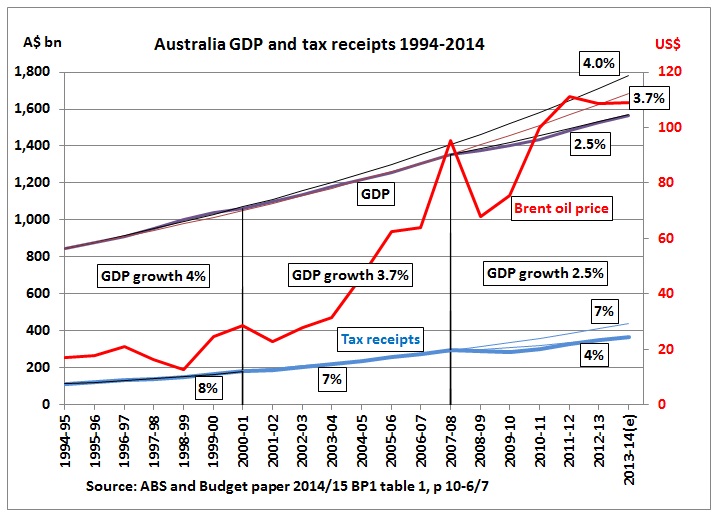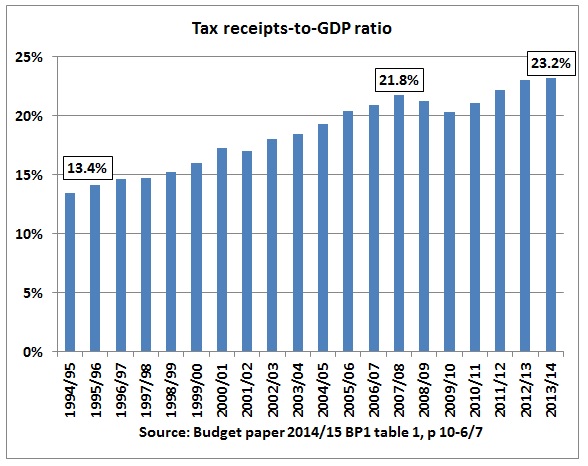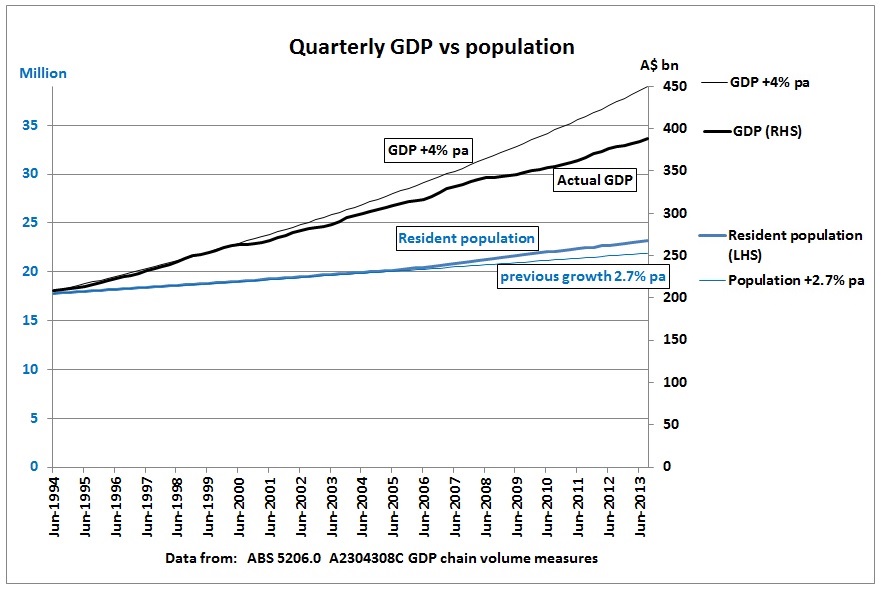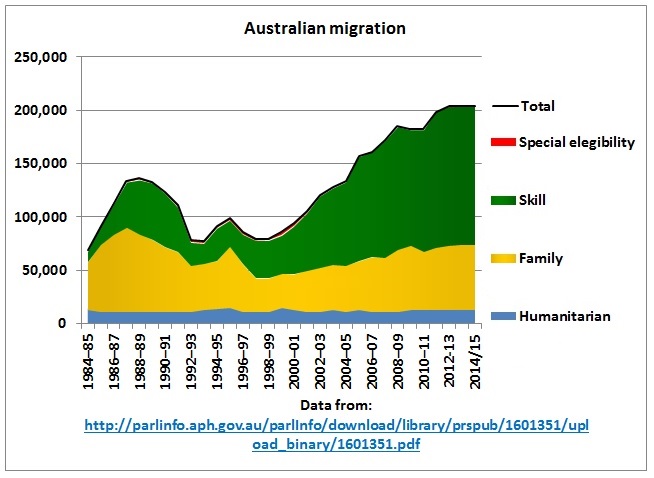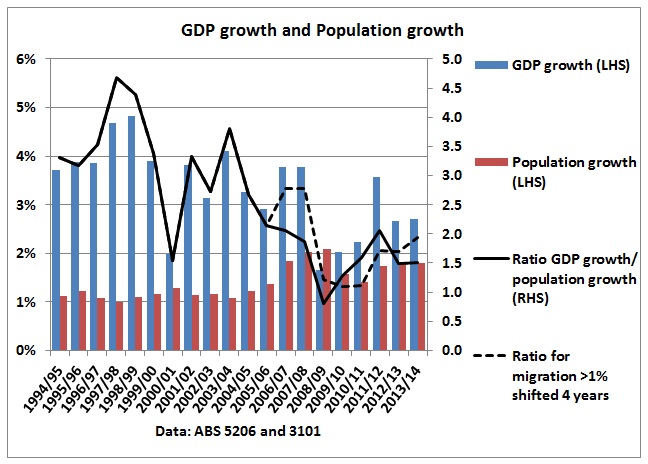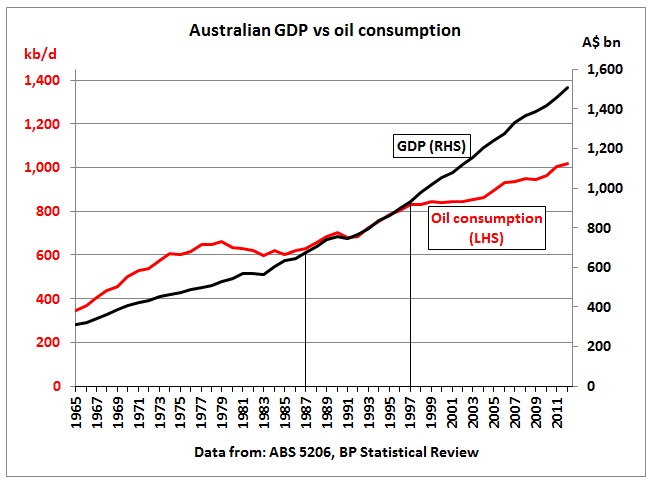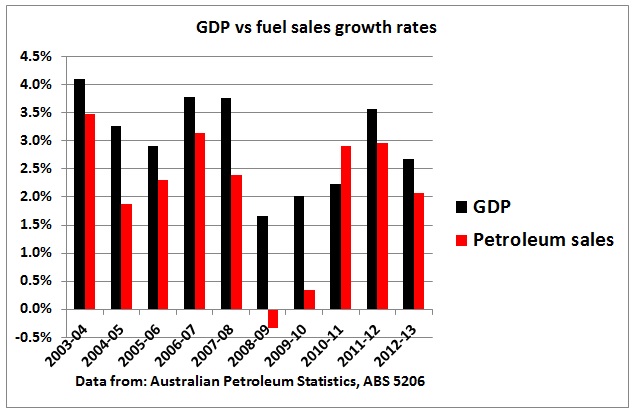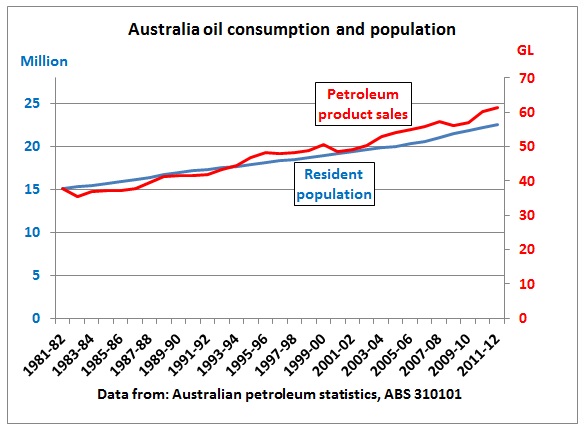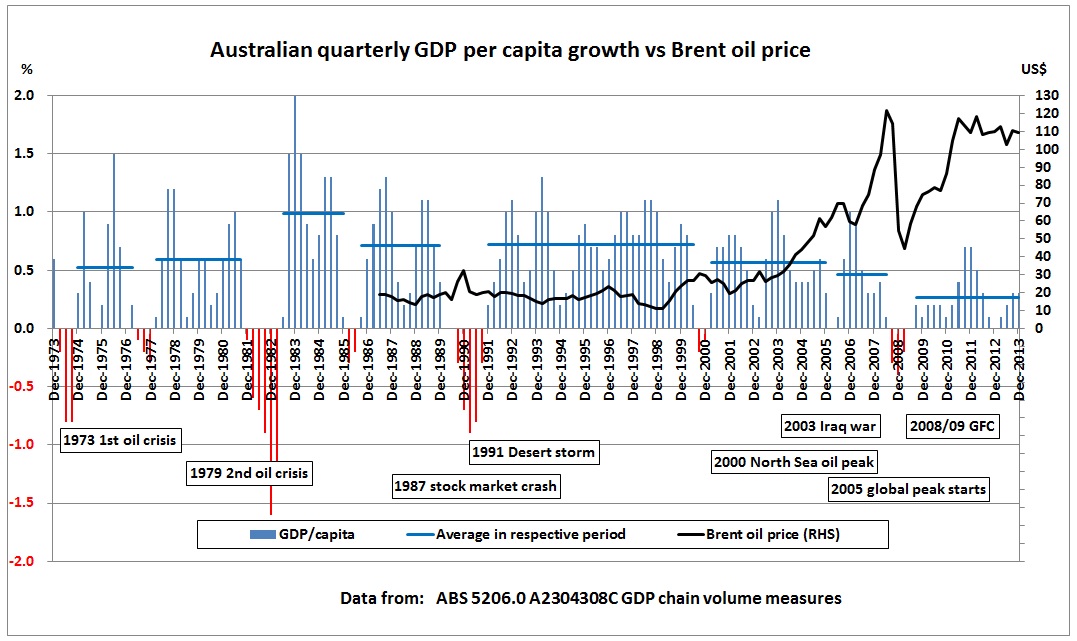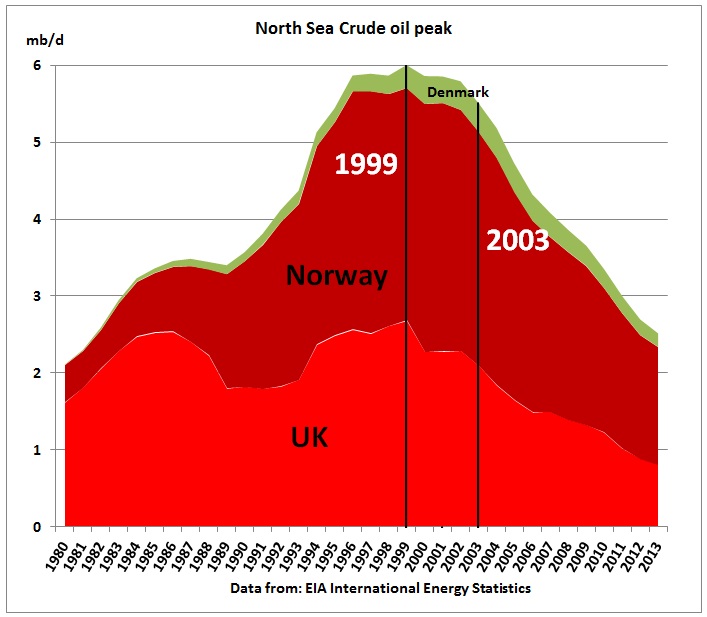In part 1 of the series on the Australian budget 2014/15 we showed that company tax receipts took a dive when the global financial crisis (GFC) hit. In this 2nd part we relate tax receipts to GDP, population, overseas migration and oil consumption
GDP and tax receipts
Fig 1: GDP, tax receipts and oil prices
This graph shows:
(a) GDP growth can be divided into 3 distinctive periods which depend on oil prices and the timing of the global financial crisis:
- 4% growth up to 2001, tax receipts growth 8% pa, oil prices between $12 and $28 per barrel
- 3.7 % growth 2001-2008, tax receipts growth 7% pa, oil prices peaking at $95/barrel
- 2.5% growth after 2008, tax receipts growth 4% pa. oil prices rising from $ 68 to around $ 110 per barrel
Thin lines show the different hypothetical growth curves. GDP would have been 13% higher in this financial year if growth rates had continued at 4%. 22% higher tax receipts would have been expected with 7% growth rates.
GDP data are from http://www.abs.gov.au/ausstats/abs@.nsf/mf/5206.0
(b) In any case, tax receipts grow faster than GDP
Fig 2: Tax receipts as percentage of GDP
Tax receipts as percentage of GDP have steadily increased except for the period in which the global financial crisis (GFC) was in its hot phase.
GDP and population growth
Fig 3: GDP and population growth
GDP grows faster than population. Just as global crude oil production started to peak in 2005, some clever people in the immigration department decided to increase Australia’s migration intake, leading to an upward kink in the population curve.
Fig 4: Australian overseas migration
But the GDP has not followed the population growth.
Fig 5: GDP versus population growth
The ratio of GDP growth to population growth has declined after a peak of 4.7 in 1998. Higher net overseas migration in the last 10 years has not changed that. In 2013/14 the ratio was only 1.5. Even if we allow for a delayed participation of migrants in the economy by 4 years (as mentioned in “Australia’s Migration Trends 2011-12” p 145) the ratio is still only 2.
GDP and oil consumption
Fig 6: GDP and oil consumption
In this graph, the oil consumption scale (LHS) is chosen in a way that for at least a certain period there is a match between GDP growth and oil consumption growth (1987-1997). Before that period, oil use was less efficient. After 1997 GDP grew faster than oil consumption. The correlation between GDP and oil consumption is very high, 95% but annual growth rates of oil consumption and GDP can vary considerably and the correlation is only around 50%. So we can work only with averages over many years. Since 1997 GDP grew by 62% while oil consumption increased by 22% suggesting that for every percentage point of GDP growth a 0.37% of oil supply growth was needed.
Fig 7: GDP and oil consumption growth rates
However, most of the oil consumption growth has happened in the last 10 years when the latter figure was actually 0.65% and without the immediate GFC impact in 2008/09 even 0.8 %, meaning that every 1 % of GDP growth requires 0.8% of oil supply growth.
Fig 8: Diesel driven economy
The growth is entirely driven by diesel and jet fuel. So if there should be price spikes or even shortages of these fuels the negative impact on the GDP would be immediate.
Fig 9: Oil consumption and population
Total oil consumption trends slightly higher than population growth. Per capita oil use has increased from 2,300 litres in the 1980s to 2,700 litres in the last 8 years
GDP per capita growth and oil price
Fig 10: Per capita GDP vs oil prices
We calculate the average GDP growth in distinctive periods between negative or zero growth events (blue horizontal lines). Since around 2000 oil prices went out of the below-$20-range of the 1990s and average GDP growth declined while oil prices went up.
What had happened? North Sea oil production had peaked in 1999 and by the time of the 2003 oil war in Iraq was down by around 10%.
Fig 11: Turning point in the North Sea
In the previous post (part1) we described how a supply shock in 2007 and a demand shock in 2008 triggered the global financial crisis which brought about a decline in GDP per capita, lasting for 3 quarters.
There are many other factors causing sluggish GDP growth:
- Capital cities beyond their limits-to-growth
- High value manufacturing in decline
- Reliance on low value bulk exports without value added processing
- Internationally operating companies repatriating their profits depriving the economy of secondary benefits
Some of these factors are also dependent on a worsening cost structure as a result of high oil prices. No doubt this requires further research but few government departments, universities or think tanks seem to have the mindset to do this work, not to mention that this would have to be commissioned by top decision makers. The end result of such studies would be the recommendation to increase substantially the productivity of using oil in the economy.
Conclusion:
High oil prices as a result of global crude oil starting to peak in 2005 have not only reduced tax revenue for the government but also impacted negatively on the GDP per capita. A desperate attempt to lift GDP by a higher net overseas migration largely failed. The next failure will be the government’s idea to replace the mining investment boom by a “roads for the 21st century” scheme.
Previous posts with relevance:
28/5/2014
Australian budget hit by global financial crisis and high oil prices
http://crudeoilpeak.info/australian-budget-hit-by-gfc-and-high-oil-prices-part-1
27/3/2014
Australian governments want to pay $810m subsidy for unviable road tunnel in Sydney as next oil price spike looms (part 1)
http://crudeoilpeak.info/australian-governments-want-to-pay-810m-subsidy-for-unviable-road-tunnel-in-sydney-as-next-oil-price-spike-looms-part-1
